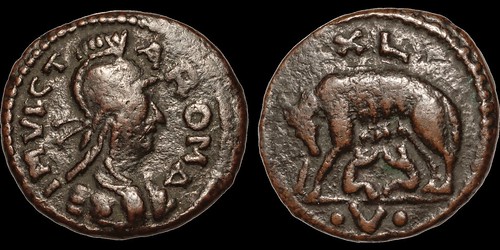
PREV ARTICLE
NEXT ARTICLE
FULL ISSUE
PREV FULL ISSUE
V25 2022 INDEX E-SYLUM ARCHIVE A BRONZE FOLLIS OF ANASTASIUSIn an email to clients earlier today, dealer Allan Davisson examined a particularly fascinating lot in the upcoming Davisson's sale. -Editor The Roman Senate issued this bronze follis long after the Rome that ruled so much of the known world had disappeared, sometime in the AD 512-522 period, during the reign of Anastasius in the East. The coin with its image of Roma on the obverse and the she-wolf suckling the twins Romulus and Remus was a distinctive use of symbols that were reminiscent of coins of the long-gone Roman Republic.
Theoderic (454-526), an Ostrogoth, had been a hostage in Constantinople when he was young. He had a Roman upbringing there and his appreciation for Roman culture was such that a modern historian, Peter Brown, states that
His life was a series of battles about ruling Italy. In 471, after the death of his father, he became leader of the Ostrogoths (471-526). In 489, Zeno, the Eastern emperor (474-491) had Theoderic march into Italy to defeat the ruler Odoacer whose claim to kingship of Italy was based on his overthrow of Romulus Augustus. The comprehensive Wikipedia entry on Theoderic notes that he A personal note: This coin came in a consignment and was unfamiliar to all three of us. In following up on the piece, I found myself spending an afternoon revisiting an era that I read about many years ago when I first ran into works by Peter Heather, an historian of this era. This period in history can be fascinating but it can also be confusing with the unfamiliar names and the shifting alliances, borders and battles.
Heather comments that During the hours I spent trying to pin the story down I found some consistency but also some variation of opinion. Wikipedia—a reference I discouraged in bibliographies when I was teaching—has what seems a particularly well researched account of Theodoric. David Sear's authentication certificate has a lengthy discussion of the background of this coin as well. And two volumes by Heather (Empires and Barbarians, The Fall of Rome and the Birth of Europe 2009. Oxford Univ. Press, and The Fall of the Roman Empire, A New History of Rome and the Barbarians 2006, also Oxford…) are particularly helpful as they place this period in a larger context.
To read the complete lot description, see:
For more information on the sale, see:
Wayne Homren, Editor The Numismatic Bibliomania Society is a non-profit organization promoting numismatic literature. See our web site at coinbooks.org. To submit items for publication in The E-Sylum, write to the Editor at this address: whomren@gmail.com To subscribe go to: https://my.binhost.com/lists/listinfo/esylum All Rights Reserved. NBS Home Page Contact the NBS webmaster 
|

